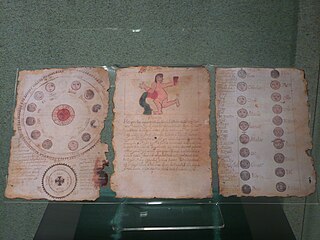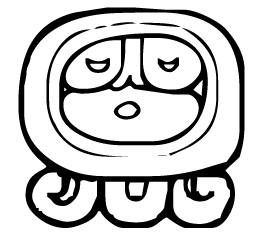
The traditional China calendar, or Former Calendar, Traditional Calendar or Lunar Calendar, is a lunisolar calendar which reckons years, months and days according to astronomical phenomena. It is defined by GB/T 33661-2017, "Calculation and promulgation of the Chinese calendar", issued by the Standardisation Administration of China on 12 May 2017.
Intercalation or embolism in timekeeping is the insertion of a leap day, week, or month into some calendar years to make the calendar follow the seasons or moon phases. Lunisolar calendars may require intercalations of both days and months.

The Mayan languages form a language family spoken in Mesoamerica and northern Central America. Mayan languages are spoken by at least 6 million Maya peoples, primarily in Guatemala, Mexico, Belize and Honduras. In 1996, Guatemala formally recognized 21 Mayan languages by name, and Mexico recognizes eight more within its territory.
The history of calendars, means that people creating and using methods for keeping track of days and larger divisions of time, covers a practice with ancient roots.
Tzolkʼin is the name bestowed by Mayanists on the 260-day Mesoamerican calendar originated by the Maya civilization of pre-Columbian Mesoamerica.

The Books of Chilam Balam are handwritten, chiefly 17th and 18th-centuries Maya miscellanies, named after the small Yucatec towns where they were originally kept, and preserving important traditional knowledge in which indigenous Maya and early Spanish traditions have coalesced. Written in the Yucatec Maya language and using the Latin alphabet, the manuscripts are attributed to a legendary author called Chilam Balam, a chilam being a priest who gives prophecies and balam a common surname meaning ʼJaguarʼ. Some of the texts actually contain prophecies about the coming of the Spaniards to Yucatán while mentioning a chilam Balam as their first author.

Classic Maya is the oldest historically attested member of the Mayan language family. It is the main language documented in the pre-Columbian inscriptions of the Classic Era Maya civilization.

Mesoamerican calendars are the calendrical systems devised and used by the pre-Columbian cultures of Mesoamerica. Besides keeping time, Mesoamerican calendars were also used in religious observances and social rituals, such as for divination.

Maya script, also known as Maya glyphs, was the writing system of the Maya civilization of Mesoamerica and is the only Mesoamerican writing system that has been substantially deciphered. The earliest inscriptions found which are identifiably Maya date to the 3rd century BCE in San Bartolo, Guatemala. Maya writing was in continuous use throughout Mesoamerica until the Spanish conquest of the Maya in the 16th and 17th centuries.

Ajaw or Ahau ('Lord') is a pre-Columbian Maya political title attested from epigraphic inscriptions. It is also the name of the 20th day of the tzolkʼin, the Maya divinatory calendar, on which a king's kʼatun-ending rituals would fall.
A veintena is the Spanish-derived name for a 20-day period used in pre-Columbian Mesoamerican calendars. The division is often casually referred to as a "month", although it is not coordinated with the lunar cycle. The term is most frequently used with respect to the 365-day Aztec calendar, the xiuhpohualli, although 20-day periods are also used in the 365-day Maya calendar, as well as by other Mesoamerican civilizations such as the Zapotec and Mixtec.

The Xiuhpōhualli was a 365-day calendar used by the Aztecs and other pre-Columbian Nahua peoples in central Mexico. It was composed of eighteen 20-day "months," called veintenas or mētztli with a separate 5-day period at the end of the year called the nemontemi. Whatever name that was used for these periods in pre-Columbian times is unknown. Through Spanish usage, the 20-day period of the Aztec calendar has become commonly known as a veintena. The Aztec word for moon is mētztli, and this word is today to describe these 20-day periods, although as the sixteenth-century missionary and early ethnographer, Diego Durán explained:
In ancient times the year was composed of eighteen months, and thus it was observed by these Indian people. Since their months were made of no more than twenty days, these were all the days contained in a month, because they were not guided by the moon but by the days; therefore, the year had eighteen months. The days of the year were counted twenty by twenty.

The Mesoamerican Long Count calendar is a non-repeating, vigesimal (base-20) and base-18 calendar used by several pre-Columbian Mesoamerican cultures, most notably the Maya. For this reason, it is often known as the MayaLong Count calendar. Using a modified vigesimal tally, the Long Count calendar identifies a day by counting the number of days passed since a mythical creation date that corresponds to August 11, 3114 BCE in the Proleptic Gregorian calendar. The Long Count calendar was widely used on monuments.

The Chʼoltiʼ language is an extinct Mayan language which was spoken by the Manche Chʼol people of eastern Guatemala and southern Belize. The post-colonial stage of the language is only known from a single manuscript written between 1685 and 1695 which was first studied by Daniel Garrison Brinton. Chʼoltiʼ belongs to the Choʼlan branch of the Mayan languages and is closely related to Chontal and especially Chʼortiʼ. The Chʼoltiʼ language has become of particular interest for the study of Mayan Hieroglyphs since it seems that most of the glyphic texts are written in an ancient variety of Chʼoltiʼ called Classic Chʼoltiʼan or Classic Maya by epigraphers and which is thought to have been spoken as a prestige dialect throughout the Maya area in the Classic Era.

The Dreamspell is an esoteric calendar in part inspired by the Maya calendar by New Age spiritualist, Mayanist philosopher, and author José Argüelles, initiated in 1987 and released as a board game in 1992.

The Maya civilization was a Mesoamerican civilization developed by the Maya peoples, and noted for its logosyllabic script—the most sophisticated and highly developed writing system in pre-Columbian Americas—as well as for its art, architecture, mathematics, calendar, and astronomical system. The Maya civilization developed in an area that encompasses southeastern Mexico, all of Guatemala and Belize, and the western portions of Honduras and El Salvador. This region consists of the northern lowlands encompassing the Yucatán Peninsula, and the highlands of the Sierra Madre, running from the Mexican state of Chiapas, across southern Guatemala and onwards into El Salvador, and the southern lowlands of the Pacific littoral plain.

The 2012 phenomenon was a range of eschatological beliefs that cataclysmic or otherwise transformative events would occur on or around 21 December 2012. This date was regarded as the end-date of a 5,126-year-long cycle in the Mesoamerican Long Count calendar, and as such, festivities to commemorate the date took place on 21 December 2012 in the countries that were part of the Maya civilization, with main events at Chichén Itzá in Mexico, and Tikal in Guatemala.

Maya astronomy is the study of the Moon, planets, Milky Way, Sun, and other astronomical occurrences by the Precolumbian Maya Civilization of Mesoamerica. The Classic Maya in particular developed some of the most accurate pre-telescope astronomy in the world, aided by their fully developed writing system and their positional numeral system, both of which are fully indigenous to Mesoamerica. The Classic Maya understood many astronomical phenomena: for example, their estimate of the length of the synodic month was more accurate than Ptolemy's, and their calculation of the length of the tropical solar year was more accurate than that of the Spanish when the latter first arrived.

In computing, a Digital Object Identifier or DOI is a persistent identifier or handle used to uniquely identify objects, standardized by the International Organization for Standardization (ISO). An implementation of the Handle System, DOIs are in wide use mainly to identify academic, professional, and government information, such as journal articles, research reports and data sets, and official publications though they also have been used to identify other types of information resources, such as commercial videos.
Michael D. Coe is an American archaeologist, anthropologist, epigrapher and author. Primarily known for his research in the field of pre-Columbian Mesoamerican studies, Coe has also made extensive investigations across a variety of other archaeological sites in North and South America. He has also specialised in comparative studies of ancient tropical forest civilizations, such as those of Central America and Southeast Asia. He currently holds the chair of Charles J. MacCurdy Professor of Anthropology, Emeritus, Yale University, and is Curator Emeritus of the Anthropology collection in the Peabody Museum of Natural History, where he had been Curator from 1968 to 1994.

The International Standard Book Number (ISBN) is a numeric commercial book identifier which is intended to be unique. Publishers purchase ISBNs from an affiliate of the International ISBN Agency.


































